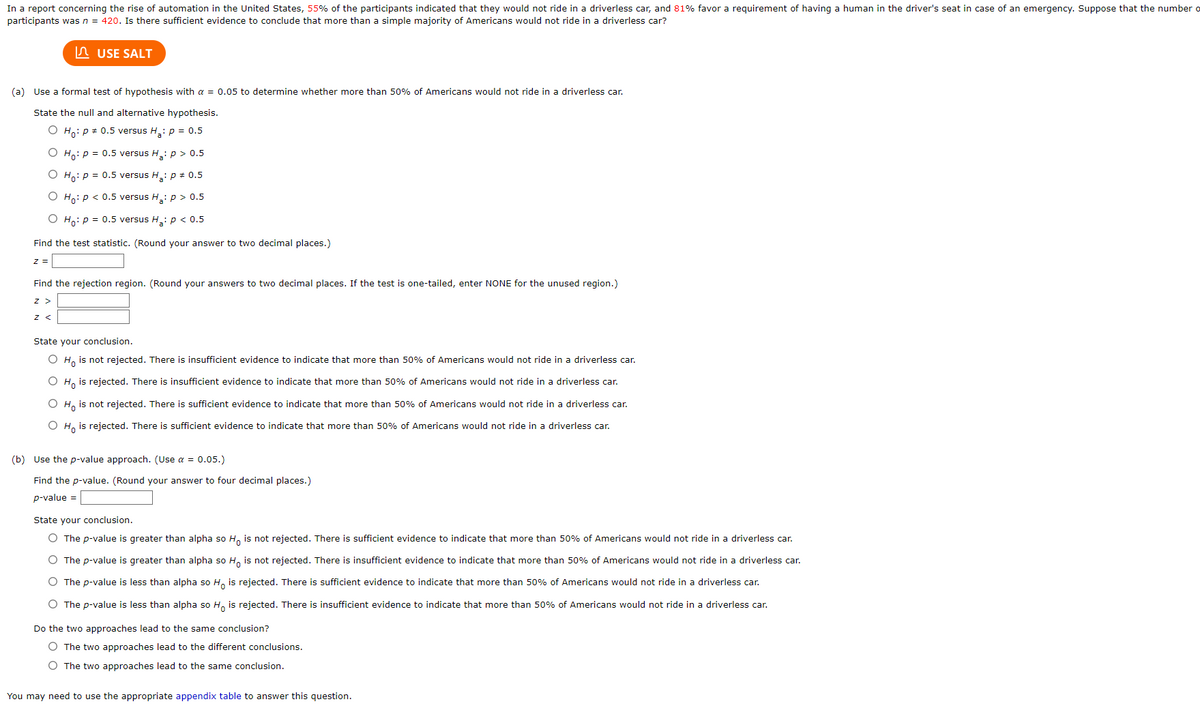In a report concerning the rise of automation in the United States, 55% of the participants indicated that they would not ride in a driverless car, and 81% favor a requirement of having a human in the driver's seat in case of an emergency. Suppose that the numben participants was n= 420. Is there sufficient evidence to conclude that more than a simple majority of Americans would not ride in a driverless car?
In a report concerning the rise of automation in the United States, 55% of the participants indicated that they would not ride in a driverless car, and 81% favor a requirement of having a human in the driver's seat in case of an emergency. Suppose that the numben participants was n= 420. Is there sufficient evidence to conclude that more than a simple majority of Americans would not ride in a driverless car?
Holt Mcdougal Larson Pre-algebra: Student Edition 2012
1st Edition
ISBN:9780547587776
Author:HOLT MCDOUGAL
Publisher:HOLT MCDOUGAL
Chapter11: Data Analysis And Probability
Section: Chapter Questions
Problem 8CR
Related questions
Question

Transcribed Image Text:In a report concerning the rise of automation in the United States, 55% of the participants indicated that they would not ride in a driverless car, and 81% favor a requirement of having a human in the driver's seat in case of an emergency. Suppose that the number o
participants was n = 420. Is there sufficient evidence to conclude that more than a simple majority of Americans would not ride in a driverless car?
A USE SALT
(a) Use a formal test of hypothesis with a = 0.05 to determine whether more than 50% of Americans would not ride in a driverless car.
State the null and alternative hypothesis.
O Ho: p + 0.5 versus H:p = 0.5
O Ho: p = 0.5 versus H: p > 0.5
O H: p = 0.5 versus H: p # 0.5
O Ho: p < 0.5 versus H: p > 0.5
O H: p = 0.5 versus H: p < 0.5
Find the test statistic. (Round your answer to two decimal places.)
z =
Find the rejection region. (Round your answers to two decimal places. If the test is one-tailed, enter NONE for the unused region.)
z >
State your conclusion.
O H, is not rejected. There is insufficient evidence to indicate that more than 50% of Americans would not ride in a driverless car.
O H, is rejected. There is insufficient evidence to indicate that more than 50% of Americans would not ride in a driverless car.
O H, is not rejected. There is sufficient evidence to indicate that more than 50% of Americans would not ride in a driverless car.
O H, is rejected. There is sufficient evidence to indicate that more than 50% of Americans would not ride in a driverless car.
(b) Use the p-value approach. (Use a = 0.05.)
Find the p-value. (Round your answer to four decimal places.)
p-value =
State your conclusion.
O The p-value is greater than alpha so H, is not rejected. There is sufficient evidence to indicate that more than 50% of Americans would not ride in a driverless car.
O The p-value is greater than alpha so H, is not rejected. There is insufficient evidence to indicate that more than 50% of Americans would not ride in a driverless car.
O The p-value is less than alpha so H, is rejected. There is sufficient evidence to indicate that more than 50% of Americans would not ride in a driverless car.
O The p-value is less than alpha so H, is rejected. There is insufficient evidence to indicate that more than 50% of Americans would not ride in a driverless car.
Do the two approaches lead to the same conclusion?
O The two approaches lead to the different conclusions.
O The two approaches lead to the same conclusion.
You may need to use the appropriate appendix table to answer this question.
Expert Solution
This question has been solved!
Explore an expertly crafted, step-by-step solution for a thorough understanding of key concepts.
This is a popular solution!
Trending now
This is a popular solution!
Step by step
Solved in 2 steps

Knowledge Booster
Learn more about
Need a deep-dive on the concept behind this application? Look no further. Learn more about this topic, statistics and related others by exploring similar questions and additional content below.Recommended textbooks for you

Holt Mcdougal Larson Pre-algebra: Student Edition…
Algebra
ISBN:
9780547587776
Author:
HOLT MCDOUGAL
Publisher:
HOLT MCDOUGAL

College Algebra
Algebra
ISBN:
9781305115545
Author:
James Stewart, Lothar Redlin, Saleem Watson
Publisher:
Cengage Learning

Holt Mcdougal Larson Pre-algebra: Student Edition…
Algebra
ISBN:
9780547587776
Author:
HOLT MCDOUGAL
Publisher:
HOLT MCDOUGAL

College Algebra
Algebra
ISBN:
9781305115545
Author:
James Stewart, Lothar Redlin, Saleem Watson
Publisher:
Cengage Learning